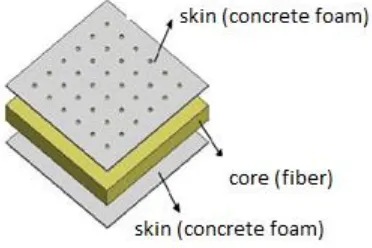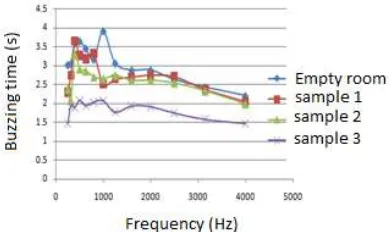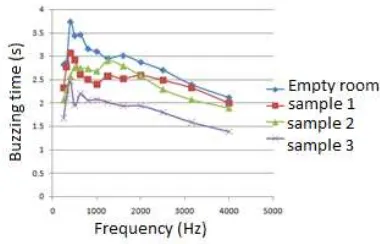Jurnal Natural
Vol. 18 (2) 2018DOI 10.24815/jn.v18i2.9706 Published June 2018
pISSN 1411-8513 eISSN 2541-4062
DESAIN OF ACOUSTIC SANDWICH COMPOSITE FROM
FOAM CONCRETE AND PALM FIBER
Devya Kartika*
1, Mursal
1and Zulkarnain Djalil
1,21
Program Studi Magister Fisika, Jurusan Fisika, Fakultas MIPA, Universitas Syiah Kuala
2Fakultas Kelautan dan Perikanan, Universitas Syiah Kuala
* corresponding Author E-mail: Devya90@mhs.unsyiah.ac.id
Abstrack. The purpose of this research were to investigate the influence of palm fiber composition and the number of hole cavities was varied with design Acoustic Sandwich Composite on sound absorption of acoustic panel. Acoustic panel were made of palm fiber as core and foam concreate as skin upper layer and bottom layer where there is a hole cavity on skin upper layer. Composition and the number of hole cavities was varied from 1 to 3 kg and the number of hole cavities from 25 to 81 hole. Sound absorption measurement was conducted by using reverberation room method based on ISO-354 (2003) with pink and white noise as sound source. The results showed that sample thickness affect acoustic absorption value effectively shifted at low frequencies, as in this research the best sound absorption occurs in panel with composition palm fiber most widely 3 kg, but coefficient absorpsi value effective is in the range of 250 Hz and use the number of hole cavities at skin upper layer of each sample effectively cause sound absorption coefficient value increased, for both pink and white noise from sound source.
Keyword : acoustic panel, foam concrete, palm fiber, sandwich composite, and absorption coefficient
I INTRODUCTION
In this modern period technological and population developments are increasing. Along with the development of technology and population then the development of equipment used by human also increasing. The equipment is in the form of information, communication, production, transportation and entertainment facilities. Most of the equipment produces unwanted sounds and is very detrimental to the surrounding environment because it can cause noise pollution. Generally speaking, noise can be addressed on three basic elements at source, transmission and receiver space. An effective way to deal with noise at the source is by moving the source out of earshot. At the receiver, noise can be overcome by wearing headphone or the like. While in the transmission chamber, noise can be overcome by using sound absorption principle that is using sound absorbing material or acoustic panel. Acoustic panel is a special material used for acoustic purposes of the room, in this case to absorb the noise. Currently, there are various kinds of acoustic panels circulating in the market. In general, the material is made of synthetic materials such as rockwool and glasswool. The material is able to reduce the
soil to prevent termite attack. Palm fibers has a durable property that is not easy to rot either in the open or closed. Palm fibers also resistant to weather, pools of acid, and sea water [3]. In the research of acoustic panel of foam fiber concrete, the panel is able to obtain coefficient of absorption value up to 1000 Hz frequency which belongs to the clarification of audioconic sound group which is medium frequency sound group. Therefore, in order to maximize its absorption capacity over a wider range of frequencies, the foam fiber-reinforced concrete panel must be modified with better shape and characterization using the same natural fiber material that is high-absorbing fibers capable of high-absorbing at high frequencies. In the manufacture of this panel, the fibrous foam concrete will be composed like Composite Sandwich, which is a composite type consisting of 3 layers of the front and back of the skin layer and the existence of cores as a porous material material that is suitable to withstand the bending, impact and can reduce vibration and sound. The design has been done in previous research is the application of sound absorbing panel from Sandwich Composite material as interior wall of the room [4]. The foam concrete panel on the front skin layer will be made into a hollow panel resonator which is a hole-shaped panel that serves as a row of cavity resonators, the hole is circular, if the hollow panel is selected appropriately will increase the efficiency of sound absorption and will widen the area of the sound frequency where the absorption is large [5]. In this study, the fibers were selected as cores, with the back skin of foam concrete and the front of a foam concrete with a row of resonator cavities that are expected to increase the absorption of sounds of foam fiber foam concrete panels on a wider frequency range.
II METHODOLOGY
Testing is done based on ISO 354: 2003 measurement of sound absorption in the hum of reverberation room (Measurement Of Sound Absorption In Reverberation Room). Sample size of foam concrete and palm fibers is 1000x1000 resonator in each sample as upper skin. Variation of thickness is 4, 5 and 6 cm. Addition of holes also varied that is 25, 49 and 81 holes on the skin
of the front of acoustic cells (Figure 1). The testing process was conducted at the Acoustical Laboratory, faculty of engineering, the building structure of Syiah Kuala University of Banda Aceh. Focused acoustic performance study at frequency range (250-4000 Hz). The acoustic performance of a material is strongly influenced by various factors. Porosity, t hickness, structure and shape and density. Acoustic performance will be obtained based on the sound absorption coefficient value which is first calculated based on the buzzing time in the blank space and the buzzing time in the space with the sample.
Figure 1 Acoustic Sandwich Composite design (ASC)
To calculate the magnitude of α in the hum speed of sound in air (m/s), S is total surface area of space (m2) and α is a average absorption coefficient [6]. The absorption coefficient of the sound of a sample can be calculated by knowing the buzzing time before and after the sample in the hum room. The first time is to measure the humming time of the empty space (before there is a sample) and then measured the buzzing time after the sample. The measurement of the buzzing time is done using a white noise source with a 1/3 octave filter. The measuring scheme of the time drone with the sample is shown in
Figure 2 Time drone measurement scheme in a hum room.
Acoustic Sandwich Composite Panel Making Process
The manufacturing process begins with the formation of a fibers into a square with the composition of each different sample The fibers in each sample are associated with a 6 cm long wire, where the wire is shaped like the letter "V" so that it can associate the fibers with the foam concrete at each angle, the number of connections as many as 4 links to each sample.
Figure 3 The shape and size of the sample
Figure 4 Acoustic Sandwich Composite Panel
The foam concrete on the acoustic panel is manufactured with a size of 1000x1000 mm in square shape and varying in thickness for sample 1 to 3. The formation in the sample begins with
the manufacture of converted foam concrete, inserted into a square-shaped mold of 1000x1000x15 mm. Square-shaped molds are provided for 3 prints, in which each mold can create 2 foam concrete as upper and lower skins. As shown in Figure 3.
III RESULTS AND DISCUSSION
The humming time is the time required by the source to be stopped immediately. the measurement of the buzzing time of either the humming time of the blank space or the space with the sample is obtained from the sound source representing the range of the human hearing frequency of White noise (Figs. 5) and Pink noise (Figs. 6).
Figure 5 Graphic frequency measurement of buzzing time in free space with White Noise source and buzzing time using samples 1, 2 and 3 against a humming time of 20 dB (T20).
that of the hum in the chamber with the sample (T2), this is because when there is no sound absorber sample in an empty hum (T1) the coming sounds will be reflected entirely within the hum room so that the measured buzzer time is greater than that of T2, which is the buzzing time when there is a sample in the hum room.
Figure 6 Graph of frequency measurement of buzzing time in free space with Pink Noise source and reverberation time using samples 1, 2, and 3 against a humming time of 20 dB (T20)
Figures 5 and 6 show that the variation of the palm mass and the number of holes found on the upper skin affect the time of buzz. This is due to the greater mass of fibers, the better the sample in absorbing sound, as well as the number of holes in the sample that is the more number of holes contained in the sample sound absorption will also be better. The same is also evident in previous research that the more the amount of material and the number of holes contained in the sample the better the sound absorption of sound.
Coefficient absorption of Acoustic Sandwich Composite design concrete board
In this research, the absorption coefficient of α sound was measured using the humming method based on ISO-354 (2003) ie the measurement of the absorption coefficient of sound in a buzzing space which will produce a reverberation time. Coefficient of absorption is the ability of an ingredient to absorb the coming sound, and has a value ranging from 0 and 1. The greater the value of the absorption coefficient of a material, the greater the ability of the material to absorb
sound, The value of α is calculated based on eqs (3), and is obtained from the sound source type of White noise and Pink noise. The value of coefficient of absorption can be seen in Figure 7 and Figure 8. The figures show the relationship between the frequency of the absorption coefficient based on the composition of the fibers
of various fibers which are 1, 2 and 3 kg and the number of holes contained in the first layer skin is 25, 49 and 81 holes acoustic sandwich composite design with using sound source Pink noise and White noise.
Figure 7 Relationship between the frequency and sound absorption coefficient based on the sound source White noise with a buzzing time at 20 dB (T20)
Figure 8 Relationship between frequency and noise absorption coefficient based on sound source Pink noise with a buzzing time at 20 dB (T20)
that it will effectively improve the viscosity damping mechanism.
In all samples tested using pink noise and white noise sources, a small portion of the absorption
coefficient value can be above 1 (α>1) and below
zero or minus as shown in Figure 7 and 8. This is caused by diffraction effects or better known edge effects resulting from wave diffraction in each corner of the sample, in addition the air gap between materials and floors can also increase coefficient minus. The same thing also happened in previous research about the effect of bagasse fiber composition on the absorption of acoustic panel sound [1]. In this study, the highest absorption coefficient value is found in sample 3 which has the greatest thickness compared to other samples and is present in low frequency range that is at the frequency of 250 Hz. This result is in line with the theory with sample thickness will shift the frequency to low frequency with high sound absorption coefficient value[9]. And it can be seen that the thicker the sample the sound absorption coefficient becomes shifted to a lower frequency. The same thing also happened in previous research, in the sound absorbing panel of Sandwich Composite material as interior wall of the room, where the increase of Noise Absorption Coefesient (NAC) value increased in low frequency range (400-1000 Hz) of 11.8% [4].
CONCLUSION
In this research has been successfully made panels with design of acoustic sandwich composite fiber-based fibers and foam concrete with masses of fibers and the number of cavities holes vary where the hole cavity is contained on the top layer skin of the sample. The thickness of the sample affects the acoustic absorption coefficient value which effectively shifts at low frequency, as in this research the best sound absorption occurs in the panel with the most fibrous fiber composition of 3 kg, but the effective absorption coefficient value is in the
range of 250 Hz. The use of the number of cavities in the skin of the initial lining of each sample can effectively cause the sound absorption coefficient value to increase with a wider frequency range due to the increased viscosity damping mechanism along with its resonance absorption mechanism. To obtain better sound absorption coefficient measurement results by using the humming method, it is necessary to note several things, namely appropriate techniques at the time of conducting research, the completeness of adequate tools, and also the feasibility of tools that facilitate the process of taking research data with more well again, so the results obtained will be more in line with the expected research.
REFERENCES
1. Zulfian. 2004. Evaluasi Performansi Akustik Mesjid: Sebuah Studi Terhadap Tipikal Mesjid Di Banda Aceh. Laporan Penelitian, Laboratorium Akustik teknik, Universitas Syiah Kuala. Banda Aceh.
2. Kartika, Devya. 2013, Pengukuran Penyerapan Suara Pada Panel Beton Busa-Ijuk, Skripsi, Jurusan Fisika, FMIPA Universitas Syiah Kuala, Banda Aceh.
3. Sarjono Wiryawan, 2008. Pengaruh Penambahan Serat Ijuk Pada Kuat Tarik Campuran Semen-Pasir dan Kemungkinan Aplikasinya. Jurnal Teknik Sipil, Vol.8, No.2, hal:159-169.
4. Yudhanto Ferriawan dkk, 2015. Aplikasi Panel Penyerap Bunyi Dari Bahan Sandwich Composite Sebagai Dinding Interior Ruangan. Prosiding Seminar
Nasional Teknologi Terapan. SV UGM.
5. Yuliantika Sonya dkk, 2015. Penentuan Koefesien Absorpsi dan Impedansi Material Akustik Resonator Panel Kayu Lapis (Plywood) Berlubang Dengan Menggunakan Metode Tabung. Jurnal Ilmu Fisika.Vol.7, No.2, September.
6. Prasetio, Lea, 1993. Akustik Lingkungan, Erlangga. Jakarta.
7. Kristiani Restu dkk. 2014, Kinerja Serapan Bunyi Komposit Ampas Tebu Berdasarkan Variasi Ketebalan dan Jumlah Quarter wavelength Resonator Terhadap Kinerja Bunyi. Jurnal Fisika dan Aplikasinya.Vol. 10, No.1, Januari 2014.
8. X. Wang, and C. Mak, Journal Acoustical Society of America, 131, 1-3 (2012).


